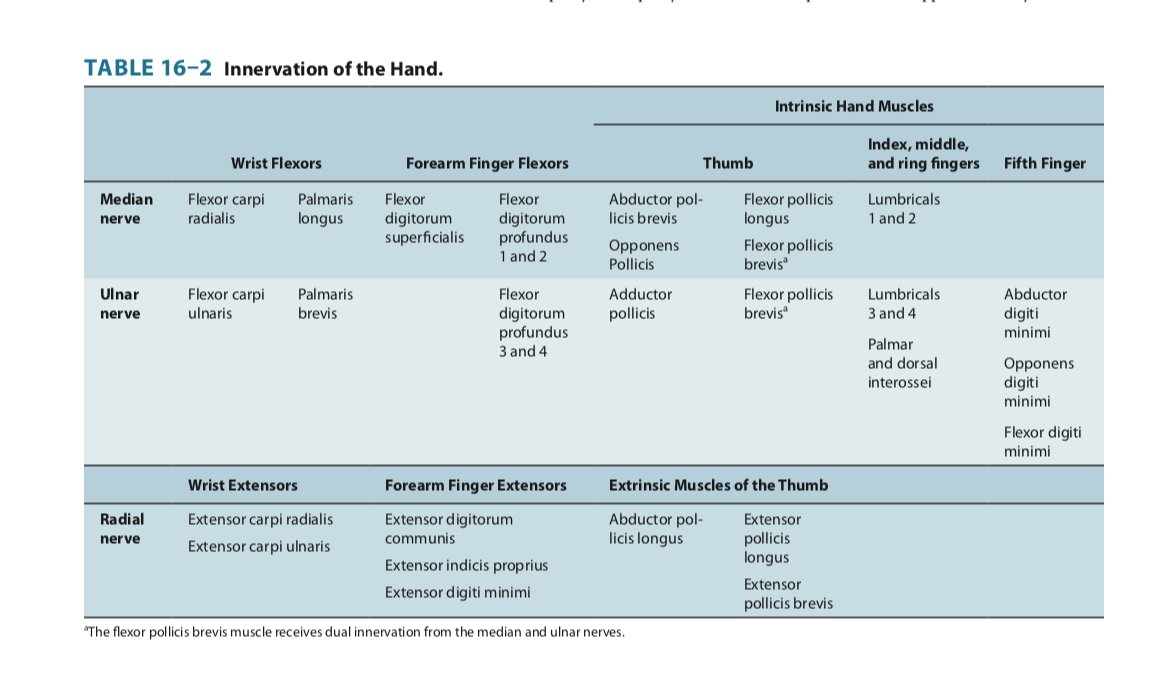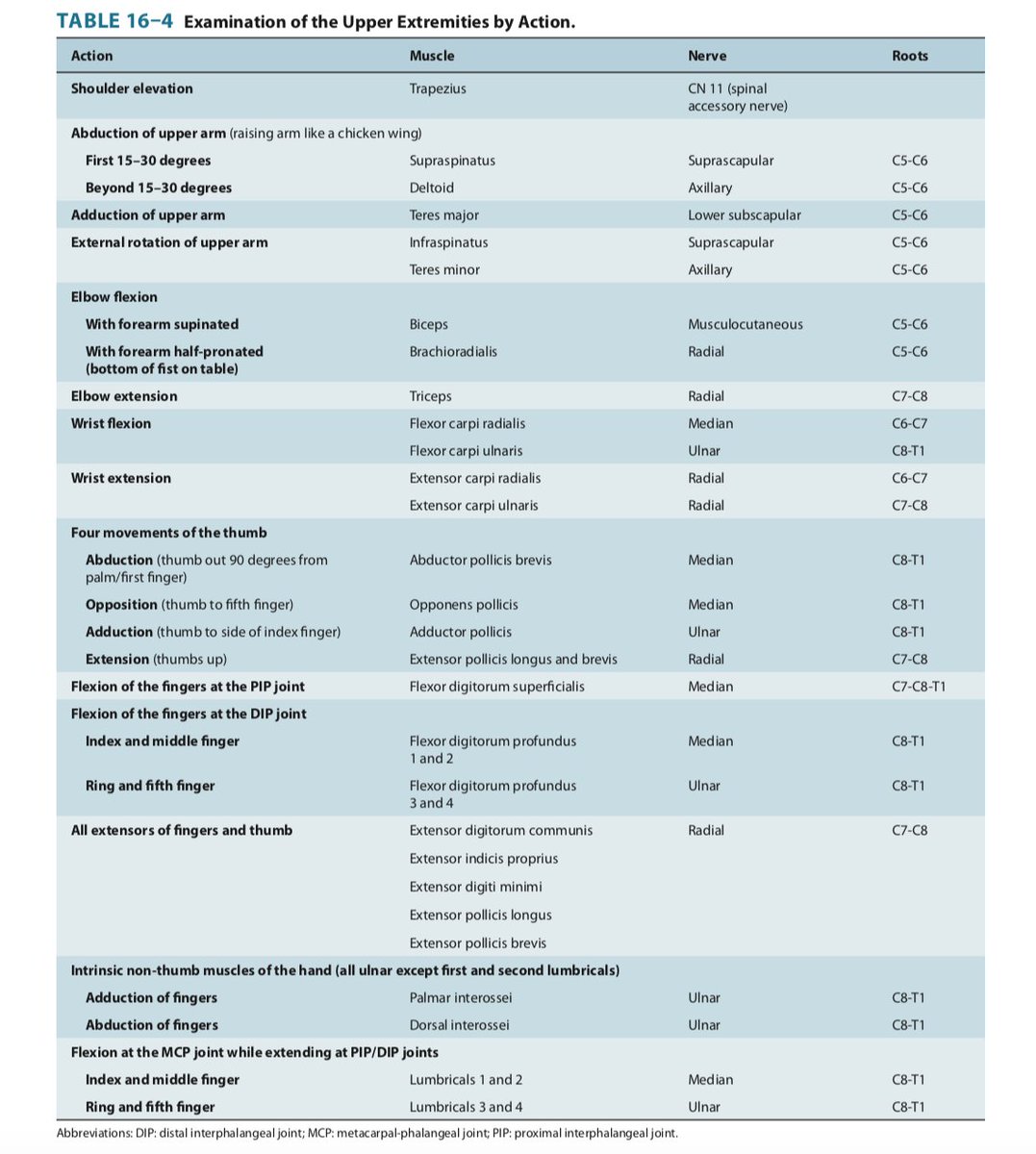Let’s cover another neuroanatomy-based approach to clinical diagnosis topic: nerves and muscles of the arm and hand.
#Neurology #MedEd #MedStudentTwitter @CPSolvers @Tracey1milligan @MadSattinJ @MedTweetorials @DxRxEdu
1
So let’s start with just 5 major nerves to the arm and hand, and come back to the plexus in a separate tweetorial for neuro geeks!
2/
Musculocutaneous
Axillary
Radial
Median
Ulnar
What’s most important to know about each nerve is:
- the muscles it supplies and their actions
- the sensory territories it supplies
3/
If you can't figure it out with just this information, you may be dealing with a radiculopathy or plexopathy!
4/
MUSCULOCUTANEOUS innervates 2 muscles:
- Biceps: elbow flexion
(Brachialis: not really clinically relevant)
Sensory: lateral forearm
5/
- Deltoid: abduction of upper arm >30 degrees ("chicken wing." (Supraspinatus does first ~ 30 degrees)
- Teres minor: external rotation of upper arm
Sensory: outer upper arm
6/
So if the muscles supplied by these nerves are affected, look for other affected muscles that could implicate a radiculopathy or plexopathy!
7/
Now we move into the more complicated nerves that are also much more commonly affected clinically.
But let's keep the big picture principles for diagnosis/localization in mind as we go!
8/
Radial nerve is the BEST
Brachioradialis (flexion of elbow when half-pronated
Extensors of forearm, wrist, fingers, thumb
Supinator
Triceps (another Extensor: of elbow)
9/
...with 2 exceptions:
Brachioradialis: similar action to biceps except with forearm turned so thumb is up
Supinator: supination of forearm (turning forearm/hand to present SoUP
10
Posterior/lateral upper arm
Posterior forearm
Dorsum of thumb, index, middle and lateral half of ring (except nail beds of index, middle, and lateral half of ring = median); medial half of ring + pinky = ulnar
So just like motor: sensory= posterior/dorsum
11/
Radial nerve compression at axilla (e.g., 2/2 crutches) also causes triceps weakness
Radial nerve compression at spiral groove (humerus fracture, or "Sat PM palsy") affects B-E-S, spares Triceps
12/
Upper motor neuron hand/arm weakness 2/2 CNS lesion (in hand knob of motor cortex) preferentially affects extensors (incl triceps) and supinator (hence pronator drift):
PSEUDOradial palsy= central fake-out for peripheral!
13/
If you relax your hand into wrist drop position, you'll see it's harder to abduct/adduct the fingers than with wrist neutral.
Don't be fooled into thinking that interossei (ulnar!) weakness accompanies wrist drop: lay hand flat and test abduction/adduction that way!
14
It's the BEST!
Brachioradialis (flexion of elbow when half-pronated
Extensors of forearm, wrist, fingers, thumb
Supinator
Triceps (another Extensor: of elbow)
15/
- Nothing above the elbow
- A few things in the forearm
- LOTS in the hand
In general:
- Median does thumb-side; Ulnar does pinky side, but there are exceptions
16/
- Flexor digitorum superficialis (flexion at PIP): ALL median
- Interossei (dorsal abduct fingers; palmar adduct fingers): ALL ulnar
- Median does pronators
- Thumb: lots happening see next tweet!
18/
Most commonly at the wrist= Carpal tunnel syndrome
- Only muscles innervated distal to wrist can be affected: Abductor pollicis brevis (thumb abduction) most common
- sensory = lateral hand (thumb side) splitting ring finger
20/
Very rarely compressed in forearm=finger flexors can be affected
Gourmet for neuro geeks:
Anterior interosseous branch (AIN) of median:
- Flexor pollicis longus
- FDP 1-2
- Pronator quadratus
(Parsonage-Turner likes this nerve and long thoracic)
21/
Most commonly at ELBOW, affecting all of its muscles:
- most noticeable in finger abduction/adduction (interossei) and FDP 3-4
- note sensory territory of ulnar is only DISTAL to wrist. So even w/compression at elbow, sensory loss only distal to wrist
22
23/
Rarely ulnar nerve can be compressed at wrist (Guyon canal): then can only affect intrinsic hand muscles: abduction/adduction, sparing finger flexors (innervated in arm)
24/
Even though the brachial plexus is proximal anatomically, to me it's distal understanding-wise😀 so we'll do that next now that you understand its most clinically important terminal branches!






